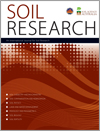SR21286Earthworms and soil mesofauna as early bioindicators for landfill restoration
 , Carlos Barreto
, Carlos Barreto  , Kevin R. Butt
, Kevin R. Butt  , Martin Lampert, Kieron Doick and Elena I. Vanguelova
, Martin Lampert, Kieron Doick and Elena I. Vanguelova
Globally, mineral extraction and landfill has resulted in an abundance of degraded land with poor soil health. We found that natural recolonisation of reclaimed landfill by soil animals occurred rapidly where original site topsoil was stockpiled, reapplied, and revegetated following best practice guidance. Our findings also show the value of recording a range of soil invertebrate indicator groups when investigating land reclamation practices, as different soil animals respond to soil disturbance in unique ways.




